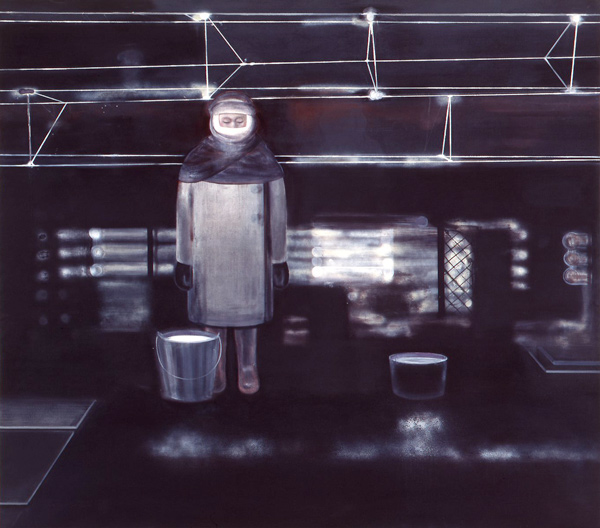Familiar Sights – catalogue text
of Gunnar Danbolt
Ulf Nilsen is a painter constantly at the verge of departure; it is as if he never quite manages to settle down in the place that he has carved out for himself. Yet, it is not hard to find connections between his earlier paintings and these new ones. He continually operates in an undefined area between the abstract and the figurative. The images cannot be seen as entirely abstract, as we often discern figures and objects that are easily identified. And yet, at the same time, certain areas keep forming on the canvas, in which the color condenses into its own reality.
However, the painterly, perceivable reality is never surface only in Ulf Nilsens’s work. He places one coat of color on top of the other, but, rather than covering one layer entirely with the next, he allows the colors to play freely amongst themselves in a transparency that lends a sense of depth to his images. Not receding backwards, as in regular pictorial space, but inwards, towards a certain center somewhere far in there.
And then, suddenly, we perceive some kind of space – a landscape with a horizon line, imbued by an immense light. In this landscape, Nilsen lets his figures move around – in a peculiar way. It seems as though nature and human beings are not quite in accordance with one another – as if they had been joined together with improper tools – as in a dream.
These are characteristics we recognize from earlier images. Yet, a new atmosphere has found its way into these paintings, which were created in New York during the fall 1998 and the spring of 1999. The fleeting views of green fields and flowing rivers often present in Nilsen’s earlier works, are now transformed into frozen water in a landscape dominated by cold and ice. In the large triptych, “Between Night and Day”, a title that seems consistent with Nilsen’s work, we are faced with a broad, open landscape in which masses of ice form the foreground, while a warm evening light comes through in the background. A figure in black, carrying a water bucket, is silhouetted against the grayish ice, and appears heavy and massive, while the two other figures are turned into viewer like spirits; immaterial and transparent. The peripheral areas are suffused by the glow of dawn: as if something is just about to happen.
Ice and Volt of the Night
Contrasts are prevalent in the two paintings, “Ice and Volt of the Night” and “A Woman and Her Echo”as well. The former depicts an urban landscape, in which a dark and brooding power plant forms the backdrop for a waiting woman, who is bundled up in white fur that a sensation of cold becomes positively palpable. There is an air of abandonment and alienation about this being, standing behind a singular and mysterious shiny bucket full of milk.
A Woman and Her Echo
“A Woman and Her Echo” is also dese with contrasts, but of a completely different nature. The landscape depicted here seems oddly pared down: A reddish moraine, surrounded by earth tones, against a bright sky. All action emanates from the very center of the piece, where one figure, wrapped in a red cloth, is pushing another person in front of himself. The other character, also clad in red, is lying on a simple cart. Hence a fragment of an action, but an action that cannot be named.
Blinded by the night
The sensation of something undefined carries over into the series “Blinded by the night” inspired by the catastrophic floods in Honduras. In these images, the viewers are, once more, confronted with grieving and despondent figures, delineated fragments of landscape; a nature that has destroyed itself.
Ulf Nilsen work with aesthetic ideas, which, according to Kant, are notions which are not defined thoughts. Hence, we never know where the center of gravity resides in these paintings – in the world of colors and forms infusing his surfaces with such a sense of depth, or in the human beings depicted in the act of searching for something we can only imagine. Or perhaps, in that area of tension between form and conception, in which so much can happen in a painters world.
Back to the exhibition



